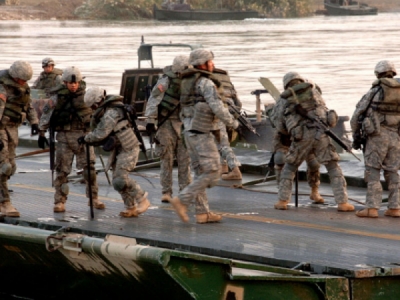
Posted on April 1, 2020
Besides building emergency hospitals in response to COVID-19, the U.S. Army Corps of Engineers does so much more.
The U.S. Army Corps of Engineers (USACE) has erected a temporary hospital at the Javits Convention Center in Manhattan, and now the Corps is in the process of constructing one at Chicago’s McCormick Place.
In a press conference, Lieutenant General Todd Semonite, the Corps’ commander, said that potentially 114 facilities nationwide could be turned into hospitals.
The Army Corps of Engineers supports both the U.S. Department of Homeland Security (DHS) and the Federal Emergency Management Agency (FEMA), and it provides security planning, force protection, research and development, disaster preparedness, and quick response to emergencies and disasters.

In a typical year, the Corps responds to over 30 Presidential disaster declarations and numerous state and local emergencies. The Corps is responsible for maintaining the U.S.’s deepwater ports through which over two thirds of all imported goods and oil flow. It is also responsible for maintaining more than 12,000 miles (19,000 km) of commercially navigable channels across the U.S.
USACE controls 609 dams within the U.S., 257 navigation locks, and it operates 75 hydroelectric facilities that together generate almost one quarter of the U.S.’s total hydroelectric power. The Corps is also responsible for some of the nation’s water supply, with USACE reservoirs supplying water to nearly 10 million people in 115 cities.
Who is the Army Corps of Engineers?
The United States Army Corps of Engineers (USACE) is an Army command comprised of more than 37,000 military and civilian personnel. In normal times, the primary work of the Corps is managing the construction of Army, Air Force, Army Reserve, and Air Force Reserve military facilities, overseeing dams, reservoirs, locks, canals, dredging operations, and flood protection around the U.S.
The Corps’ stated mission is to: “Deliver vital public and military engineering services; partnering in peace and war to strengthen our nation’s security, energize the economy and reduce risks from disasters.” Its motto is “Essayons”, which is French for “Let Us Try.”
The Corps traces its origins to 1775 when the Continental Congress recognized the new country’s need for engineers. Lacking any of their own, the Congress appealed to French King Louis XVI for help.
Louis dispatched former French officers, one of whom was a lieutenant colonel in the French Royal Corps of Engineers named Louis Lebègue Duportail. In May 1779 when the Continental Congress created the first Corps of Engineers, Duportail became its commander.
Early works by the Corps included the building of fortifications at Bunker Hill near Boston, and siege works at the Battle of Yorktown. In 1802, President Thomas Jefferson established the Corps of Engineers as part of the United States Military Academy at West Point.

As anyone who has read Mark Twain knows, during the early 1800s, the Mississippi and Ohio Rivers were full of navigational hazards including sand bars and trees trunks stuck to the bottom of the riverbed. The Corps of Engineers was tasked with removing these hazards.
During the mid-1800s, the Corps surveyed the Great Lakes and other U.S. lakes, and created nautical charts for them. Along with the U.S. Navy, the Corps was responsible for all the U.S.’s lighthouses.
The Civil War created a need for engineers
Engineers graduating from West Point during 1861 were faced with the dilemma of joining either the Union or Confederate armies. Famous general George McClellan joined the Union, and Robert E. Lee joined the Confederacy.
Engineers on both sides set about constructing roads, bridges, forts, batteries, and pontoon and railroad bridges.

Following the Civil War, in 1884, the Corps completed construction of the 555 foot (169 m) tall Washington Monument, and in 1914, the Corps completed work on the Panama Canal.

The Panama Canal connects the Atlantic and Pacific oceans, and it is a system of locks, dams, and lakes that lifts ships through rugged mountains and lowers them into coastal bays.

During World War II, the Army Corps of Engineers constructed buildings for aircraft and tank assembly, ammunition plants, living spaces for 5.3 million soldiers, depots, ports, and hospitals.
The Corps oversaw the construction of the massive Pentagon in northern Virginia, which was completed in 1943, and the creation of an entire city in the desert around Los Alamos, New Mexico for the Manhattan Project, which was responsible for the creation of the atom bomb.
Following WWII, the Corps lent construction support for the building of the Manned Spacecraft Center in Huston, TX, and the Kennedy Space Center at Cape Canaveral, Florida.

Today, the Army Corps of Engineers includes the:
- U.S. Army Engineer School (USAES), which operates seven laboratories
- Engineer Research and Development Center (ERDC)
- U.S. Army Engineering and Support Center (CEHNC)
- U.S. Army Corps of Engineers Finance Center (CEFC)
- Humphreys Engineer Center Support Activity (HECSA)
- Army Geospatial Center (AGC), which provides geospatial information, sets standards and provides support for the Department of Defense
- Marine Design Center (CEMDC)
- Institute for Water Resources (IWR)
- USACE Logistics Activity (ULA), which provides supply, maintenance, materiel, and transportation support
- Enterprise Infrastructure Services (CEEIS), which includes the Army Corps of Engineers Information Technology (ACE-IT)
- Deployable Tactical Operations System (DTOS), which provides mobile command and control platforms in emergency response missions for national and international events
- 249th Engineer Battalion (Prime Power)
- 911th Engineer Company
- 412th Theater Engineer Command
- 416th Theater Engineer Command.
Source: interestingengineering





